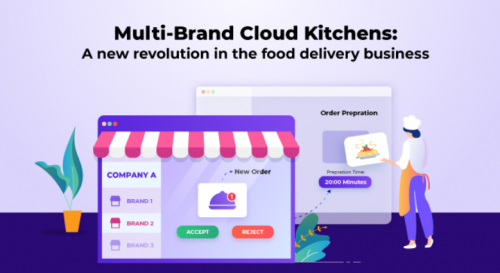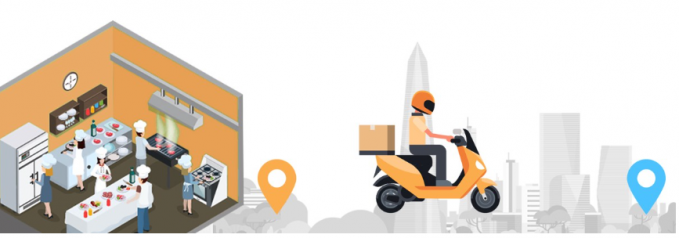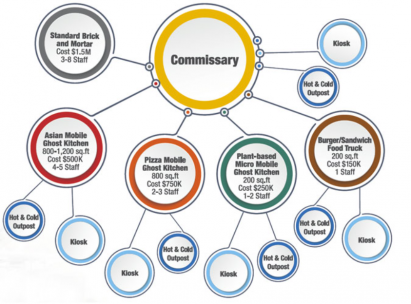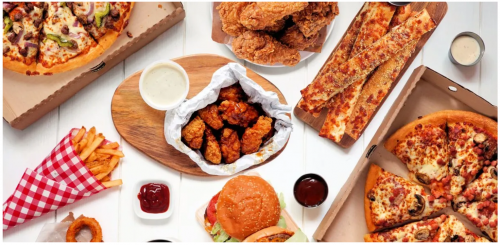The food industry suffered due to the pandemic. Because of the lockdown, the governments ordered the businesses to remain inaccessible for an extended period Even after the lockdown, restaurants have to close their eating areas to prevent the virus from spreading.
Therefore, online food delivery has become the primary source of revenue for most eateries and hotels. These circumstances led to the origin of cloud kitchen business models.
A cloud kitchen is a place that cooks food for online orders and delivers it to customers. It's the primary source of revenue for many restaurants, catering services, and hotels.
A new report released by Allied Market Research revealed that the Cloud Kitchen Market was valued at USD 29 billion in 2020 and is expected to reach USD 113 billion by the end of 2030, drastically growing at a Compound Annual Growth Rate of 13.12% from 2021 to 2030.
The significant growth in this market can be attributed to many factors, including increasing demand for convenience food and hospitalization rates due to food-borne illnesses.
Cloud Kitchen Business Model
1. Brand Owned Cloud Kitchen
This is your best option as a brand if you want to get into the business of delivering food to customers' homes. A cloud kitchen that serves only a single cuisine does not provide dine-in dining or takeaway food service options.
The kitchen is typically situated in a region with more affordable rents, but it is still not overly remote from areas with a high population density. It is highly streamlined and a relatively small operation, and it only has a skeleton crew.
To maximize exposure, orders and deliveries are managed by multiple aggregators simultaneously. There are times when the kitchen also runs a self-delivery service, mainly if it's a well-known brand.
There is indeed a low initial investment required here; however, this is only the case if we discuss a new entrant deciding between a cloud kitchen and a dine-in restaurant.

Compared to starting a standalone eatery or even just expanding an existing business, investing in a cloud kitchen is always a more cost-effective choice.
Scaling a business takes work, but it can be done. The best strategy for scaling requires making a minor adjustment to the model,
which entails expanding the original operation and establishing a centralized kitchen from which all brands can operate under one roof (but on separate floors).
There are only two drawbacks to this model:
first, the initial investment is more significant than what is required by the majority of other models, and second, scaling the business may be challenging if there is not enough money or labour available to expand the original operation and establish a centralized kitchen.
2. Dine-In Brand with A Separate Delivery Production Line at The Restaurant
Many restaurants are interested in expanding their delivery services, but they do not wish to open a dedicated delivery location.
What if you could set up a side business that focuses solely on delivery while keeping the actual cooking operations at your existing restaurant?
This cloud kitchen model is ideal for restaurants that specialize in dine-in service and want to compete in the delivery market. This version of the cloud kitchen operates as a dine-in restaurant that serves as a delivery and takeout business.
The restaurant essentially takes the most popular items from its menu and modifies them so that they can be delivered.

Despite appearances to the contrary, the vast majority of these cloud kitchens are not thrown up on the spot; instead, there is a method behind how this is accomplished.
With the assistance of this cloud kitchen model, you will be able to launch your new company in a matter of days, get it off to a strong start, and begin making money as quickly as is practically possible.
Even though the functionality of this cloud kitchen is limited in comparison to that of other cloud kitchens, it can still be helpful for restaurants that want to increase their volume but don't want to make a significant initial financial investment.
Scaling the business of this cloud kitchen is highly challenging because cloud kitchens already operate dine-in restaurants and the fact that taking orders from dine-in customers and online customers could confuse the restaurants.
3. Dine-In Brand That Works from One Or More Shared Cloud Kitchen Locations
This model could be an excellent fit for you if you want to grow your customer base and expand your business, which are goals that this model can help you achieve.
The dine-in operation of the business is already set up with this model, but the cloud kitchen component of the business is physically separated from it and operates out of a shared kitchen space.
If you choose to implement this strategy, your company will run an additional operation out of rented space within a shared kitchen.

By doing so, you will be able to broaden your customer base without worrying about the cost of purchasing and maintaining additional equipment or locating additional space at your current location.
If you want to try out new menu items or broaden your customer base without taking on too much risk, this is a fantastic choice to consider.
To accommodate the additional operating costs of a second kitchen in your current location, you will need to make certain that there is sufficient space available. If not, then it's possible that this method isn't going to work for you.
However, if you already have some physical space available, this might be an excellent way to take your existing brand and expand it without building out new physical space or purchasing new equipment.
This is only the case if you already have some physical space available.
The primary benefit of using this model is that it enables you to expand your company without requiring a significant initial financial investment.
And if everything goes according to plan, you can always make more room for growth by opening up additional locations.
The only drawback is that it might be challenging to quickly scale up this model because it calls for more initial investment and more time than other models. This is the only potential drawback.
4. Hub And Spoke Cloud Kitchens
The hub and spoke cloud kitchen model is one of the most common ways to structure a food service business.
The Hub and Spoke model is similar to the Pop-up model, but it requires less initial capital and is easier to scale. It's also a good idea if you want to get started with a single brand first, then expand your business later on.
In this model, most of the food is made in a central kitchen and then sent to smaller pop-up locations for finishing touches.

These locations are strategically placed to cover more ground under the last-mile delivery concept. Each of them has a centralized production unit where most of the items are premade and then pop-up locations that facilitate reach (and where things are finalized).
The point is to have a production hub located in a low-rent area (to keep costs down), where most items are prepared in advance and sent off to smaller pop-up locations.
This allows you to cover more ground efficiently under the last-mile delivery concept by having strategically placed pop-up locations that facilitate reach.
This is a variation on having multiple kitchens that serve as production hubs, with smaller pop-up locations that facilitate delivery.
These smaller locations can be rented or owned and located in areas where rent is cheap, like industrial zones or low-income neighborhoods.
5. Numerous Virtual Brands in a Shared or Business-Owned Kitchen
This model could be an excellent fit for you if you want to grow your customer base and expand your business, which are goals that this model can help you achieve.
The dine-in operation of the business is already set up with this model, but the cloud kitchen component of the business is physically separated from it and operates out of a shared kitchen space.
If you choose to implement this strategy, your company will run an additional operation out of rented space within a shared kitchen.
By doing so, you will be able to broaden your customer base without worrying about the cost of purchasing and maintaining additional equipment or locating extra space at your current location.

If you want to try out new menu items or broaden your customer base without taking on too much risk, this is a fantastic choice to consider.
To accommodate the additional operating costs of a second kitchen in your current location, you will need to make sure that there is sufficient space available. If not, then it's possible that this method isn't going to work for you.
However, if you already have some physical space open, this might be an excellent way to take your existing brand and expand it without building out new physical space or purchasing new equipment.
This is only the case if you already have some physical space available.
The primary benefit of using this model is that it enables you to expand your company without requiring a significant initial financial investment. And if everything goes according to plan, you can always make more room for growth by opening up additional locations!
The only drawback is that it might be challenging to quickly scale up this model because it calls for more initial investment and more time than other models. This is the only potential drawback.
6. Shell Kitchen with Outsourced Food Prep, Delivery, and Support
The model of the cloud kitchen is a little bit difficult to understand. It is a takeaway restaurant, but they do not have a kitchen. Instead, it contracts out all of the food preparation and delivery work to other more experienced businesses in those areas.
The finishing touches, including the addition of garnishes and serving dishes, are the only thing that the cloud kitchen does on its own.
It obtains all of its orders through aggregators, and once it has them, it raises the price of the dish before billing the customers for it.
This indicates that this model is great for scaling quickly because you do not have to worry about finding new locations or setting up your kitchen. Instead, all you need to do is focus on growing your business.
Because they already have a well-known brand name and knowledge that is easily portable from one location to another, food businesses can quickly scale thanks to the cloud kitchen model, which also offers the advantage of not worrying about locating new sites or recruiting additional workers.
Additionally, because they have already established relationships with their suppliers, they can easily find high-quality ingredients at prices significantly lower than what they would be if they had to start from scratch in each location.
7. Cloud restaurant in A Dependency of Commissary
Kitchens at a Commissary (Aggregator) are cloud kitchen business models that the company does not own and operate. Many eateries will share everything from the refrigerator space to cooking area.
For the most part, it's a bare cooking surface with only the most basic of appliances and plumbing in place with essential kitchen equipment, like gas pipelines, ventilation systems and drainage.
These kitchens are typically large enough to house multiple businesses, but each company has its location and brand identity.
For example, a single cloud kitchen may be home to several restaurants, but each restaurant will have its menu items and branding. This way, restaurants can focus on what they do best: serving delicious meals.
Conclusion
Cloud kitchen concepts make it possible for all restaurant customers in different locations to enjoy the same quality of food and same delivery services.
The cloud kitchen concept has gained popularity in recent years thanks to the advancement in technology that helps businesses stay ahead of their competitors.
The cloud kitchen business model aims at achieving the vision of on-demand delivery of foods. Therefore, it has many advantages over other business models.
Consequently, it is worth exploring more and improving it to make it a profitable business model. The concept might seem strange today, but it will have become a way of life for restaurant owners in the coming years.
These restaurant tech ideas and strategies will help build a strong network that will make your venture more profitable in the future.
The food tech industry has been on a roll over the past few years, and the evolution of cloud kitchens is an exciting new dimension that can transform this sector.
As we witness technology enter every aspect of our lives, cloud kitchens will play an important role in how we order food in the next decade. Dark or Cloud Kitchens refer to delivery-only restaurants that provide food with no dine-in options or pick-up counters.
The kitchen can be shared across multiple brands and have a dedicated delivery team, who deliver food through online aggregators like Zomato, Swiggy and Uber Eats amongst others.
Frequently Asked Questions
1. What is the business model of cloud kitchen?
The business model of a cloud kitchen is simple: it's an online-only restaurant that has no physical space for dine-in. Instead, it is entirely reliant on online orders placed via online food aggregators, a website, or a mobile app that supports online ordering.
Cloud kitchens are a great way to start a restaurant, especially if you don't have much capital, to begin with.\
By eliminating the need for a physical space, cloud kitchens reduce overhead costs and free up more money for marketing and advertising. They also make it easy for customers to find them (since there aren't many other options).
2. Are cloud kitchens profitable?
Cloud kitchens are not as profitable as some people think they are. Cloud kitchens, like other businesses, have their own set of challenges. Cloud kitchens can be very beneficial, and; operations in cloud kitchens are much easier to scale than dine-in operations.
However, in order to be profitable, the cloud kitchen business requires high online order volumes.
The low overheads of a cloud kitchen help offset the fact that these businesses typically have high operational costs because they need skilled labor, equipment maintenance, and space rent.
This means that you need more customers ordering from your website or app for your business to turn a profit—or at least break even!
3. How much do you need to start a cloud kitchen?
Starting a cloud kitchen is a difficult task. It takes a significant investment, especially if you are starting a franchise. A cloud kitchen requires a minimum investment of INR 25 to 30 lakhs to get started.
This includes lease, equipment, interiors, licences and registration, franchise security deposit, franchise fee, and operational costs such as workforce salary and rent.
4. Can I start a cloud kitchen from home?
Absolutely! You can do it if you have a home-based business and want to start a cloud kitchen. You'll need to put in the effort first to ensure that your process is working correctly and that you can deliver the food on time.
Once you've established a reliable system, you'll be able to grow your business from there.


